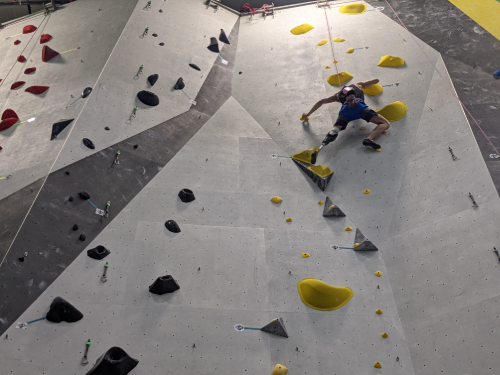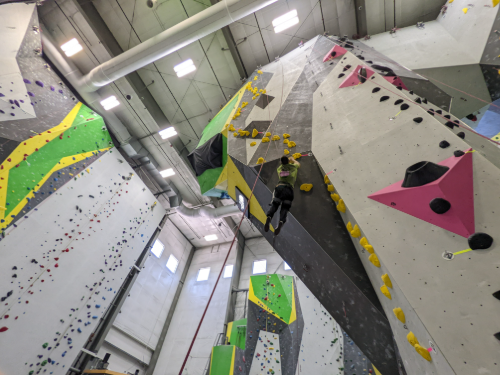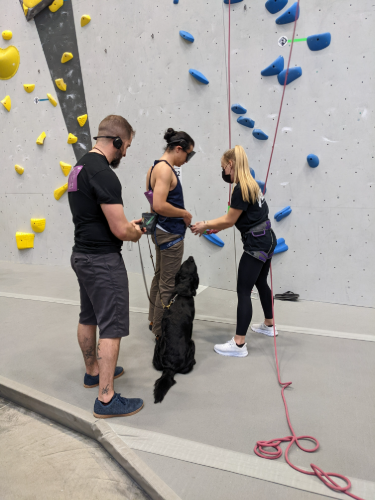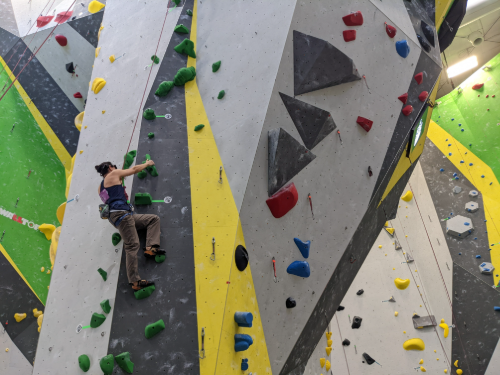Paraclimbing National Championship
3/26/2022
Over the weekend I participated in a USA Collegiate Climbing competition for the first time in Birmingham Alabama, the Southeastern Regional Championship. Unbeknownst to me until my arrival, the US National Paraclimbing Championship would be immediately following the lead portion of the collegiate championship! I was not taking part in the bouldering portion of the collegiate championship, so after the lead portion I was just there to support my bouldering friends, however there is a lot of waiting involved. While I waited for the bouldering to get underway, I was drawn back into the ropes area where the Paraclimbing National Championship was taking place. I walked around and observed different routes and climbers working to qualify for worlds, sat on a bench and watched the championship happen around me, and chatted with an RP1 climber. The experience made me feel a lot of things and have a lot of thoughts, which I hope to put into words here.
The Rules
Normally, championships divide between women and men competitors, then have them compete to see who can make it the highest on a route, and, should multiple competitors reach the top, who can do so most consistently and/or the fastest. However, in paraclimbing, the very reason for its existence is that peoples disabilities creates an uneven playing field. They compensate for this by ditching the sex division and simply dividing by type and severity of disability.
I won't get into the nitty gritty of it, but I think it's worth getting a basic overview using the RP category as an example.
RP stands for Range and Power, which is for climbers with a neurological/physical disability. RP1 is the most severe and RP3 is the least severe. Routes are set with different categories in mind, so you might have an RP1/RP2 route and an RP3 route. This would tailor each route to be attainable for each competitor and silo them to competing with others who find the route similarly difficult.
A comprehensive description of the classification system can be found here.
Information about USAC Paraclimbing in general can be found here.
Thoughts

A climber missing one leg high on the route
One thing that struck me about all the climbers there was the tenacity they must posess to have showed up at all. I was there at the collegiate competition because I said "fuck it, why not?" and that took me all the way there. These people though? They have to persevere through so much to climb at all, let alone get all the way to a competition far from home to compete against other people in front of an audience!
I watched one man climb who had severe cerebral palsey. He rocked up to each climb in a mobility scooter, hooked in to the rope, and got on the wall. He shook all over, I could see how hard he had to concentrate to put his hand or foot onto a hold. When he would move up a foot, he would far overshoot the hold he was aiming for then slide his foot down the wall until it hit the hold and he could stand up on it; only then would his leg stop trembling. He would only stop when he careened backwards off the wall and someone on the ground would snag a gear loop on his harness to prevent him from swinging back into the wall. He would rest for a bit, then do it all again! While he never made it much higher than 6 feet or so, it was plain to see that on every route he got on, he tried as hard as I've ever tried on my hardest projects.

An AL1 (seated) climber halfway up a route. Yes, they literally JUST use their arms!
Later in the day, while I was sitting on a bench, a competitor named Melissa sat next to me. We got to chatting and I learned so much from her. She was in the RP1 category due to her cerebral palsey, which affected every muscle group in her legs and much of her core. If anyone tells you that all you need are strong arms to climb, Melissa will personally tell you that they're full of shit. Because she has very little control over her legs, she basically has to haul them up the wall with her arms. Able-bodied climbers can move their legs up, then push down with them to help propel them up the wall. Melissa can't do that, but she taught me a few really cool tricks she uses to make the best of them! She has enough control over them to be able to place them on top of holds so she doesn't have to hold up their weight on top of the rest of her. If she has to get a high foot, she'll hang from one arm and use her other arm to physically grab her leg, pick it up, and put it on the hold. While we sat she pointed out a climber to whom she taught that trick giving us a perfect demo halfway up the wall!
Melissa also brought me back down to earth a bit. While I was sitting alone, watching everyone climb, I got to thinking about how connected everyone must be to each other and what a great community resource it is for them, as I imagined how isolated they must feel at their home gyms climbing routes set for the able-bodied. Well, it turns out the paraclimbing community is much like any other community. While I'm partially right that it's a good community resource and builds connections and provides role models for other people with disabilities, Melissa casually pointed out a man with a similar disability to her, saying "See him over there? I'm really excited to see him climb that route to see what he does at the part where I fell. He's kind of a dick, but a good climber."

A blind climber next to his caller, shortly after arriving back on the ground, where his very cute guide dog rushed to meet him
At one point observing the paraclimbing championship, Noel, the head setter at UNC and a fellow competitor at the collegiate championship joined me. He voiced some thoughts that I hadn't even considered: how would people with inherently different disabilities adjust their beta for the same routes? For able-bodied climbers, the main considerations to beta are height and how flexible one is. For paraclimbers though, one of them might be missing their right leg and the other might be missing their left! Or, if they are missing the same leg, they might be wearing a prosthetic of a different length. I saw one climber without a prosthetic at all, they simply had their knee wrapped up tight with a rubber thing to keep their skin safe! These differences change the question about beta from the able-bodied "What do I need to do to make it up this route?" to "is it physically possible for me to make it up this route?"
I have a friend, Mark (incidentally, he gave me the belay on my first ever trad lead!), who has had his leg reconstructed multiple times due to bone cancer. This has left one of his legs shorter than the other. He can read a route and instantly know whether he should even bother getting on it at all.

A blind climber making his way up higher
I got to thinking: "How could I possibly fathom what it's like to be a paraclimber?" Any of the RP categories are pretty much right out, since I imagine it's near impossible to simulate a neurological disorder short of making different parts of your body fall asleep, then attempting to race up the wall before they wake up.
Actually, as I write that, it sounds like it would be interesting to try, but I promise I had some actual ideas before sitting down to write this. One could conceivably replicate a seated climber by simply not pushing with one's legs, but it's really impossible to simulate a core that won't engage. Plus, one could still use their legs as ballast, which a true seated climber would be unable to do.
My best bet for true replication is blindness! Blind climbers will climb with blindfolds on (to account for different levels of blindness, it causes every competitor to climb under the exact same conditions) and have headphones with mics connected with a caller on the ground, who will inform the climber of where holds are as they climb. I was lucky enough to stand near a caller and watch a blind climber as he climbed, and the system they had was fascinating! They had an efficient system of analog clock directions for direction and distance: I.E "Hold medium 2 o'clock from your left hand." I spoke about this briefly with Melissa and she pointed out that this would only work if the climber had ever seen a clock! This really had me considering things we, as able-bodied folk, take for granted about daily life. Although, now that I think about it even someone blind from birth could be taught to use that system using a relief of an analog clock, but it wouldn't have any significance as a time-keeping device, only as a climbing aid.
Climbing Blind
The first day I got to climbing after returning from Alabama, I had to try climbing blind. I got one of my good friends, Phil, to try it out with me, and it was quite the experience. Each rope at UNC serves 2-3 routes, so there was a certain amount of "not that one, further left!" from the belayer/caller, but we made it work.
While I had considered the implications of climbing blind on technique and physical demand of climbing, I wasn't prepared for it's effects on my confidence. You know that feeling you get when you walk with your eyes closed? The nervous, paranoid feeling that you're going to walk into or off of something at any moment, even if you're in the middle of a field? That feeling, and any semblance of that feeling, was totally gone. Thinking back on it, I think it's because you move so slowly while climbing. Climbing normally, the procedure is get to a stance, look for the next hand or foot hold, then reach to use it. The exact same is true for climbing blind, except instead of looking for a hold with your eyes, you look for a hold with your hands or feet.
This brings me to a more practical difference I noticed. Endurance is much more of a factor, since you spend so much time feeling about while clinging to what holds you have. Basically, a blind 5.10 climber would probably be a seeing 5.12 climber.
Final Thoughts
This experience really had me thinking a lot about the things we take for granted about our lives, and about our perceptions of people with disabilities.
I had a weird dichotomy of feeling like I'm incredibly lucky to be as healthy as I am, but also feeling like I'm not that different from people with disabilities. I noticed that, especially with the more severe physical disabilities, the mind has a tendency to dehumanize them and reduce them to their disability, which overshadows the very normal human brain, feelings, and thoughts they possess.
Thankfully, these contrasting feelings came together to inspire me. If all those badass paraclimbers tearing it up out there aren't that different inside from me, a healthy, able-bodied young man, I really have no excuses to let anything prevent me from going after my goals!
Keywords: paraclimbing national championship, equity, mindfulness, disability